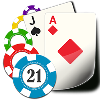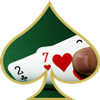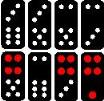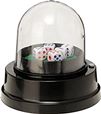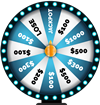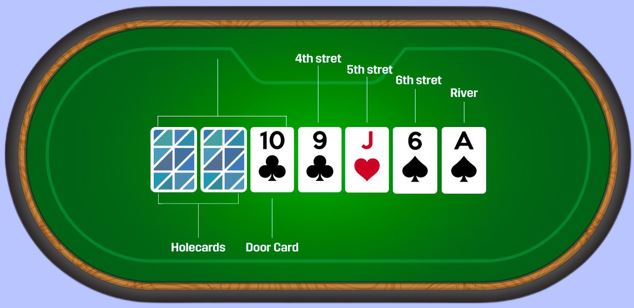Unfolding a blow
ante
Before starting a hand of 7 Card Stud Poker, all players must place a forced bet in the pot, called “Ante”. The amount of the ante varies according to the parties. This is the amount to be paid to receive cards.
Distribution and “Bring in”
Each player receives three cards: two face down and one upside down. The player whose visible card is the lowest must act first, and place a minimum bet called “Bring in” or, if he wishes, a full bet of the lowest betting level, called “Small bet”.
In the event of a tie between two or more of the displayed cards, the color of the cards is used to decide between them. Suits are ranked in this order: clubs (lowest), diamonds, hearts, and spades (highest).
The lowest color wins: if the 2 of hearts and the 2 of clubs are visible at the start of the move, it is the 2 of clubs that must act first. (Note that this color hierarchy is only used in this case, and does not apply to showdown.
If, for example, two players show at the end of a hand Ace-10-8-5- 2 clubs (for one) and Ace-10-8-5-2 diamonds (for the other), their hands are considered identical, and the pot is split.)
3rd street _
After the player showing the lowest card has bet a “Bring in” or a “Small Bet”, the round continues clockwise: each player has the choice to resign (“Fold”), equalize (“Call”), or raise (“Raise”).
For each round of betting, the number of raises authorized is limited to three and progress by increments corresponding to the amount of the “Small Bet” (Example: in a game at €2/€4, they are made in increments of €2).
If a player’s bet or raise is not matched by any of his opponents, then that player wins the pot, and the bet ends immediately. This rule is valid for the whole move.
4th street _
Each player receives a new visible card, called “Fourth Street”. The first player to act is the one whose uncovered cards are the strongest. In the event of a tie, the color of the cards is used again (see the previous paragraph). The highest color of the highest visible card wins.
The first player to act can “Check” (which corresponds to a bet of zero) or “Bet” (a bet corresponding to the amount of the “Small Bet”). If subsequent players decide to bet, the floor will then return to the player or players having “Check”, and they will have the choice to pay (“Call”) or raise (“Raise”) if the maximum number of raises has not yet been reached. If all the players decide to “Check” during a given round, we go directly to the next round.
The round continues clockwise. When all bets and raises have been equalized, the next round can begin.
5th street _
Each player receives a new visible card, called “Fifth Street”. Again, the first player to act is the one who’s exposed cards are the strongest. In the event of a tie, the above rules apply.
The round continues in a clockwise direction, according to the rules previously stated.
From Fifth Street and until the end of the round, all bets progress by increments corresponding to the amount of the “Big Bet”, generally double the amount of the “Small Bet” (Example: in a game at €2/ 4€, they are made in increments of 4€).
6th street _
Each player receives a new visible card, called “Sixth Street”. Again, the first player to act is the one whose exposed cards are the strongest. In the event of a tie, the above rules apply.
The round continues in a clockwise direction, according to the rules previously stated.
7th street _
Each player receives a seventh and last card, closed (and therefore known only to the player receiving it). The first player to act is the one whose uncovered cards are the strongest. In the event of a tie, the above rules apply.
The round continues in a clockwise direction, according to the rules previously stated.
Slaughter
If there are several players left at the end of the last betting round, the last player who bet or raised must show their cards first. If there was no bet in the last round, the player who first “Checked” in that round must show their cards first. When slaughtering, the hands are revealed in a clockwise direction.
The winner of the pot is the player showing the strongest five-card combination, according to the hierarchy described in the “Hand ranking” paragraph. If one or more players reveal an identical combination of cards, the pot is shared equally between them. Once the pot has been awarded to the winner(s), a new hand can begin.


